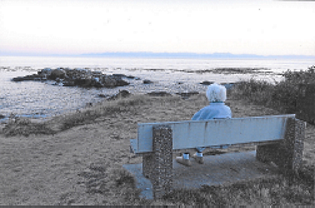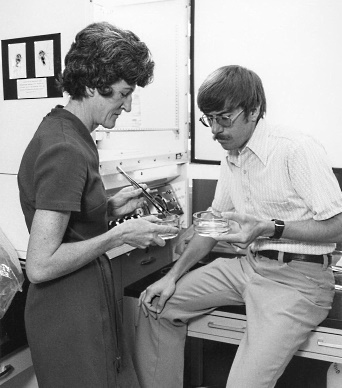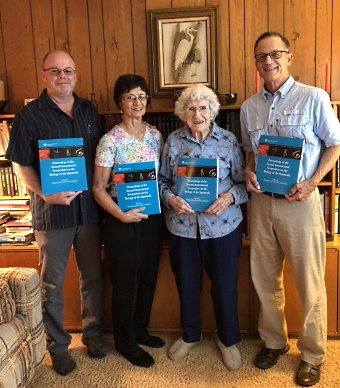 (Photo provided by Mary Rice) |
Look to the sea –
That’s where I will be.
Look to the sky
And the birds that fly.
See the fields and the trees,
Feel the soft, cool breeze.
Know that I have become
With all of them – One.
– Mary Esther Rice
Mary Esther Rice – Scientist, Mentor and Friend
Dr. Mary E. Rice was the first Director of the Smithsonian Marine Station (SMS) in Fort Pierce, Florida, a tropical branch of the Smithsonian Institution. She was a remarkable woman and the pillar of many scientific careers, through her Life Histories Research Program at SMS. She was also a brilliant and fiercely independent woman, scientist, person. Her specialty was the marine invertebrate Sipunculans and she would capture larvae from the biodiverse Gulf Stream and culture them through metamorphosis to match the larvae with their adult form. Kevin Eckelbarger was hired right out of graduate school as a Research Scientist by Florida- based Harbor Branch Oceanographic Institution (HBOI) in 1973 and was a close colleague of Mary’s for eighteen years. He arrived just as Dr. Rice started the Life Histories Program at SMS (see photo). Mary’s first postdoctoral fellows were Ed Ruppert and John Pilger, and she mentored a number of postdocs, graduate students and faculty who went to SMS to do research. Mary embraced molecular biology as a tool and added a Molecular Lab at SMS for visiting scientists to use when they visited, as well as the resident scientists. Her last few postdoctoral fellows continued on her sipunculan research with biocoding and sequencing larvae and adults. Mary’s last Postdoctoral Fellow, Dr. Michael Boyle will carry on the Life Histories Research Program at SMS (see photo).
Mary Rice was born on a farm in Maryland to Daniel and Florence (Pyles) Rice and was a precocious child. She had one younger sister, Frances, and an older brother named Daniel. She had a pet crow named Pete who learned to talk and tease visitors from the tree above. She also told me of her love of cats and that she would send stray kittens from Drew College in Maryland back to the farm if she couldn’t find an owner. She loved Biology and majored in it to receive her Bachelor of Science at Drew College. There were only three Biology majors then. She had a mentor who went to the Marine Biology Laboratory (MBL) at Woods Hole, MA in the summertime and she went several summers to do research there.
Mary felt that she finally found her calling while taking the Embryology course at the Marine Biological Laboratory (MBL) in Woods Hole, MA in 1945. Mary fell in love with embryos and larvae during the course and decided to make it her research topic. World War II was raging then and there were few men in school or applying for summer courses, and Mary felt that helped her get accepted to the Embryology Course. The course Director at the time was Victor Hamburger, who was known to take the students out for a sail on his sailboat from time to time. Another faculty in the Embryology course was Jane Oppenheimer, who also later became the first female President of the Society for Integrative and Comparative Biology (SICB). Dr. Mary E. Rice was the third female President of SICB, which was then called the American Society of Zoology (ASZ) and she also served as President of the American Microscopical Society. She was a regular at the meetings for years, attending talks, going to dinner and exchanging Christmas gifts with friends. She was also a fellow of the American Association for the Advancement of Science. She was lifelong supporter of women in science, but she denied ever being treated differently because she was female.
In 1961, Mary moved to the University of Washington to do graduate work on invertebrate development. She was a student of Dr. Robert Fernald, along with Fu-Shiang Chia, Colin Hermans, and Russel Zimmer. Mike Hadfield was also a UW graduate student at this time and they all became life-long friends and colleagues. Dr. Fernald told them each to pick an invertebrate group, and Mary chose Sipunculans. Mary finished her PhD in 1966 and went to the Smithsonian Institution to become a curator in the Department of Invertebrate Zoology. In 1981, she became the Director of the Smithsonian Marine Station until she retired in 2002. In 2019, Dr. Mary E. Rice won the A.O. Kovalevsky Medal from the St. Petersburg Society of Naturalists for her work in Comparative Embryology, Development and Evolution of sipunculans.
Mary spent summers on San Juan Island, continuing to work on sipunculans and winters at Fort Pierce in Florida. She retained a love for the Friday Harbor Labs at the University of Washington where she had done her graduate work and continued to foster the Embryology Course by starting the Robert Fernald fund to support students taking the course. She would continue to work at getting the sipunculans to spawn and was always up for a spontaneous dissection and description of their internal anatomy to students. Everyone who met Mary was impressed by her intelligence, her grace and poise. She will be missed by many students, collaborators and friends.
Professor Billie J. Swalla
 Mary and Kevin Eckelbarger |

Michael Boyle, Julie Piraino, Mary Rice, Hugh Reichardt

